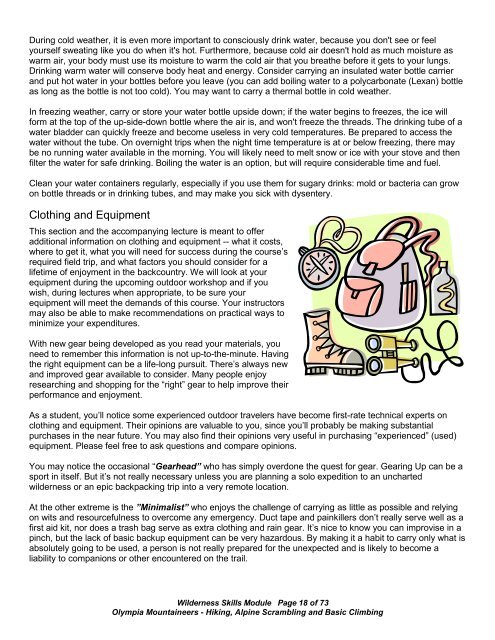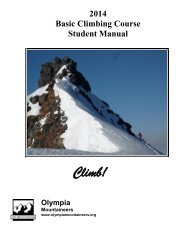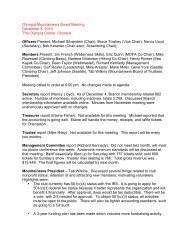Wilderness Skills - Olympia Mountaineers
Wilderness Skills - Olympia Mountaineers
Wilderness Skills - Olympia Mountaineers
You also want an ePaper? Increase the reach of your titles
YUMPU automatically turns print PDFs into web optimized ePapers that Google loves.
During cold weather, it is even more important to consciously drink water, because you don't see or feel<br />
yourself sweating like you do when it's hot. Furthermore, because cold air doesn't hold as much moisture as<br />
warm air, your body must use its moisture to warm the cold air that you breathe before it gets to your lungs.<br />
Drinking warm water will conserve body heat and energy. Consider carrying an insulated water bottle carrier<br />
and put hot water in your bottles before you leave (you can add boiling water to a polycarbonate (Lexan) bottle<br />
as long as the bottle is not too cold). You may want to carry a thermal bottle in cold weather.<br />
In freezing weather, carry or store your water bottle upside down; if the water begins to freezes, the ice will<br />
form at the top of the up-side-down bottle where the air is, and won't freeze the threads. The drinking tube of a<br />
water bladder can quickly freeze and become useless in very cold temperatures. Be prepared to access the<br />
water without the tube. On overnight trips when the night time temperature is at or below freezing, there may<br />
be no running water available in the morning. You will likely need to melt snow or ice with your stove and then<br />
filter the water for safe drinking. Boiling the water is an option, but will require considerable time and fuel.<br />
Clean your water containers regularly, especially if you use them for sugary drinks: mold or bacteria can grow<br />
on bottle threads or in drinking tubes, and may make you sick with dysentery.<br />
Clothing and Equipment<br />
This section and the accompanying lecture is meant to offer<br />
additional information on clothing and equipment -- what it costs,<br />
where to get it, what you will need for success during the course’s<br />
required field trip, and what factors you should consider for a<br />
lifetime of enjoyment in the backcountry. We will look at your<br />
equipment during the upcoming outdoor workshop and if you<br />
wish, during lectures when appropriate, to be sure your<br />
equipment will meet the demands of this course. Your instructors<br />
may also be able to make recommendations on practical ways to<br />
minimize your expenditures.<br />
With new gear being developed as you read your materials, you<br />
need to remember this information is not up-to-the-minute. Having<br />
the right equipment can be a life-long pursuit. There’s always new<br />
and improved gear available to consider. Many people enjoy<br />
researching and shopping for the “right” gear to help improve their<br />
performance and enjoyment.<br />
As a student, you’ll notice some experienced outdoor travelers have become first-rate technical experts on<br />
clothing and equipment. Their opinions are valuable to you, since you’ll probably be making substantial<br />
purchases in the near future. You may also find their opinions very useful in purchasing “experienced” (used)<br />
equipment. Please feel free to ask questions and compare opinions.<br />
You may notice the occasional “Gearhead” who has simply overdone the quest for gear. Gearing Up can be a<br />
sport in itself. But it’s not really necessary unless you are planning a solo expedition to an uncharted<br />
wilderness or an epic backpacking trip into a very remote location.<br />
At the other extreme is the ”Minimalist” who enjoys the challenge of carrying as little as possible and relying<br />
on wits and resourcefulness to overcome any emergency. Duct tape and painkillers don’t really serve well as a<br />
first aid kit, nor does a trash bag serve as extra clothing and rain gear. It’s nice to know you can improvise in a<br />
pinch, but the lack of basic backup equipment can be very hazardous. By making it a habit to carry only what is<br />
absolutely going to be used, a person is not really prepared for the unexpected and is likely to become a<br />
liability to companions or other encountered on the trail.<br />
<strong>Wilderness</strong> <strong>Skills</strong> Module Page 18 of 73<br />
<strong>Olympia</strong> <strong>Mountaineers</strong> - Hiking, Alpine Scrambling and Basic Climbing




